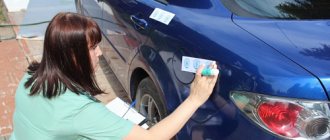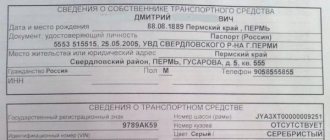| Question | Answer |
| Where can I apply for temporary termination of car registration? | In any branch of the MREO, regardless of the place of registration of the car and the registration of the owner. |
| What documents are required to formalize temporary termination of registration? | · certificate from the police about the initiation of a criminal case; · documents for the vehicle; · passport of the vehicle owner; · application for termination of registration. |
| Where can I find an application for deregistration of a vehicle? | Follow this link and check it out. |
| How much does it cost to temporarily stop registering a car with the traffic police? | The service is free. |
| Will the traffic police accept an application to terminate the registration of a car without a passport? | If your passport is lost or left in a stolen car, your application will not be accepted without it. You need to restore your passport. |
| How can an owner deregister a stolen car using the State Services website? | · go to your personal account in the “Driving and Transport” section. · go to the “Vehicle Registration” section. · Select the item “Deregistration”. · Go to the “Termination of vehicle registration” section. · Click the “Get service” button · Enter all data. It is necessary to indicate the reason for the withdrawal, select a convenient MREO department and time of visit, and fill out information about the vehicle. · Check the box “I am familiar with the procedure for providing services” and click the “Submit application” button. |
If a car owner is a victim of theft, he needs to deregister the car in order to avoid paying taxes and fines. If car thieves get into an accident or commit another crime using a stolen car, the former owner will not have to prove his non-involvement in the incident.
Theft or theft is considered to be the alienation of a vehicle without legal grounds (Articles 158 and 166 of the Criminal Code of the Russian Federation). This can happen without the knowledge of the owner or due to the threat of violence against him. However, in the traffic police database the car continues to be registered with its previous owner. In order not to pay tax and not be held responsible for illegal actions committed by car thieves, he must notify law enforcement agencies and deregister the car.
Registration actions with vehicles are regulated by Orders of the Ministry of Internal Affairs No. 605 and 1001. The traffic police do not deregister a stolen car, but temporarily suspend registration. All data is saved in the database, but an appropriate note is made. Thus, if the car is found, it will not be difficult to register it again. At the same time, when performing registration actions with the car, the information that the vehicle is listed as stolen will immediately become known to the inspector.
What is this
Theft is a synonym for theft, but this concept is applied specifically to vehicles. That is, this is a willful illegal action aimed at taking possession of a car or other vehicle without the purpose of stealing it.
Most often, theft is of a commercial nature.
That is, a stolen car is repainted, slightly repaired and sold as a completely different car. This is precisely why the risk of buying a previously stolen car is so great.
Transport tax
But for transport tax, the fact that a stolen car is written off from accounting accounts does not matter.
The fact is that vehicles that are on the wanted list are not subject to transport tax (subclause 7, clause 2, article 358 of the Tax Code of the Russian Federation). That is, the basis for not charging transport tax is not the writing off of the car from the balance sheet, but the fact of theft. But the fact of theft (theft) must be confirmed by a document issued by an authorized body. Such a document is a certificate issued by the authorities of the Ministry of Internal Affairs of Russia (GUVD, OVD, ATC, etc.), as stated in the Letter of the Federal Tax Service dated September 30, 2015 No. BS-3-11 / [email protected]
The same letter states that before deregistration of a stolen vehicle on the above grounds, the taxpayer, in order to exempt this vehicle from taxation, must annually confirm the fact that the stolen vehicle is wanted.
What is it for
If the car is stolen, you must immediately call the police or visit the nearest police station yourself.
This is necessary so that the fact of committing illegal actions is documented.
Documents are needed to deregister the car. This is done to save money for the car owner until the car is found. As soon as he deregisters it, he is exempt from paying transport tax and will be deregistered with the tax office.
As soon as the vehicle is found and returned to the owner, it will again need to be registered with the traffic police.
Other purposes of deregistering a car after theft:
- exclusion of car sales;
- saving money on paying for an MTPL policy;
- resolving issues with the bank if the car was purchased on credit.
When can a stolen car be deregistered?
Sometimes stolen cars are found and returned to their owners. In other cases, the property is said goodbye to forever. But it is imperative to contact the police, where a criminal case will be opened on this matter. Without explaining the reason, that is, documents from there, it will not be possible to deregister the vehicle from the traffic police and tax authorities.
A certain period of time is allotted for the investigation of a theft case, usually 2 months. By decision of management, it can be extended for another 90 days, but this does not always happen. At the end of the specified period, and if the search for the car is unsuccessful, the police issues a cease-and-desist order.
The applicant, that is, the owner of the stolen vehicle, receives a notice that the case is closed. From this moment on, he can begin the procedure for deregistering the equipment with the traffic police.
You need to appear at the MREO in person, preferably by making an appointment in advance. You should take with you:
- passport;
- documents for the car, if preserved;
- notification from the police about the termination of the criminal case of theft.
The car owner must fill out an application form for deregistration of the vehicle, indicating the reason. After acceptance and verification of the submitted documents, the registration of the car with the traffic police will be terminated. The owner must submit the certificate to the MREO. And if the car is found and returned to him, a new document will be issued.
Where to contact
You must contact the traffic police department. Since in 2013 the procedure for registering and deregistering a car was simplified, you can contact any traffic police department, and not the one where the car was registered.
In addition, it is now possible to contact government agencies using the World Wide Web. The State Services portal has been successfully operating for several years . With its help, you can register your car or deregister it.
You can also visit the official website of the traffic police and complete all registration actions through it.
Should VAT be restored?
If, when purchasing a car that was stolen, the “input” VAT was deducted, then the question arises: should the company restore the VAT?
We think it shouldn't. However, practice shows that in cases where property is damaged or stolen, tax authorities demand that the VAT previously accepted for deduction be restored. Such explanations were also given by officials from the Ministry of Finance of the Russian Federation (Letter dated May 15, 2008 No. 03-07-11/194). And if such property is an object of fixed assets, then the tax must be restored from the residual value of the property.
The tax authorities' reasoning is as follows. One of the conditions for deducting VAT is the use of the object in activities subject to VAT. And since the fixed asset was disposed of before the expiration of its useful life, it means that it ceased to participate in transactions subject to VAT. Consequently, the deduction condition is partially not met, so part of the “input” VAT must be restored.
However, the courts did not share this approach and arbitration practice for many years has generally developed in favor of companies (Resolution of the Seventeenth Arbitration Court of Appeal dated November 10, 2015 No. 17AP-12892/2015-AK in case No. A60-19040/2015, FAS Moscow District dated 04.10 .2013 in case No. A40-149597/12). The courts took into account the following arguments. Paragraph 3 of Article 170 of the Tax Code of the Russian Federation provides for cases in which tax amounts accepted for deduction by the taxpayer on goods (work, services), including fixed assets and intangible assets, property rights, are subject to restoration. Shortage of goods does not apply to the cases listed in paragraph 3 of Article 170 of the Tax Code of the Russian Federation. Therefore, there is no need to recover VAT on stolen objects.
Later, a Letter from the Federal Tax Service dated May 21, 2015 No. GD-4-3/ [email protected] , which states that the amounts of VAT previously legally accepted for deduction cannot be restored when property is disposed of as a result of a fire. Although the letter talks about the disposal of an object as a result of a fire, we believe that the officials’ conclusions also apply to the disposal of objects for other reasons (for example, as a result of theft).
Let’s hope that local tax authorities will not ignore the explanations of their “management” and will stop demanding that companies restore VAT on stolen objects. But even if the inspectors restore the VAT on the stolen car, the company has every chance to challenge the tax authorities’ decision in court.
Procedure
How to deregister a stolen car?
To deregister a stolen car, you must follow the following procedure:
- write a statement to the police that the car was stolen;
An example can be seen here.
- wait for all necessary procedures to be completed and a criminal case to be initiated;
- receive a notification from the preliminary investigation authorities or inquiry authorities that the criminal case has been terminated or suspended;
- Visit the nearest traffic police department and submit all the necessary documents. You can also use the official website of the State Traffic Safety Inspectorate or the State Services portal .
Don't know what the difference is between theft and theft? See the article about this: how theft differs from theft. What types of car theft schemes exist is written here.
Property tax
From the moment the inventory results are reflected in the accounting records in connection with the revelation of the theft of an object of fixed assets, the residual value of this object ceases to participate in the formation of the tax base for property tax.
This follows from paragraph 1 of Article 374 of the Tax Code of the Russian Federation, which states that the object of taxation for property tax is movable and immovable property recorded on the balance sheet as fixed assets in accordance with the established accounting procedure. Since, according to the results of the inventory, the stolen fixed asset was written off from account 01 “Fixed assets” to account 94 “Shortages and losses from damage to valuables”, it is no longer included in the tax base for property tax.
What documents are needed
To deregister a car due to theft, you must submit the following documents to the traffic police department:
- application in the appropriate form;
The form can be obtained from the traffic police department or filled out in electronic format on the traffic police website or on the portal .
- your passport;
- registration certificate for the car;
- a document confirming the applicant’s ownership of the car;
- a document confirming that the applicant has paid the state fee.
When submitting documents through the State Services portal, 30% discount on the fee. The discount is valid from 01/01/2017 to 01/01/2019.
Copies must be made of the applicant’s passport, vehicle registration certificate and registration certificate. There is no need to have it certified by a notary.
You also need to present a document that confirms the fact that a theft case has been initiated, suspended or closed. This certificate is provided by law enforcement agencies.
How to deregister a car with the traffic police in 2021 - the most detailed article with step-by-step instructions
Monitoring the implementation of the registration procedure will allow you to avoid unwanted fines that mistakenly arrive at the residence address of the old owner of the car. In case of malicious evasion from registering the purchase, the new owner needs to be prepared for large fines.
The reasons why car owners find themselves in a difficult situation and are simply not competent in matters are a large number of innovations regarding the priority of actions in the event of selling a car and the transfer of all accompanying documentation for the car.
- the “deregistration” procedure is a thing of the past;
- there is no mandatory connection of the car to the place of registration, registration takes place in any region of the country;
- temporary license plates are issued only as a result of traveling abroad;
- The registration time for vehicles has been reduced.
When buying or selling a car in 2021, you must understand that you are entering into a transaction under which ownership of the vehicle passes from the seller to the buyer.
Of course, if the transaction is made between individuals, you may not sign any documents, simply enter into a so-called “friendly deal” between each other, as a result of which, having agreed on a price, without signing any documents, you can exchange money and a car, i.e. The buyer receives ownership of the car, and the seller receives money.
By participating in the process of buying and selling a vehicle, in which the document “Car Purchase and Sale Agreement” will be drawn up, the seller of the car undertakes to transfer ownership of the car to the buyer, and the buyer undertakes to accept the car, also, according to the agreement, the buyer undertakes to pay the specified amount for the purchased car amount of money in the contract. Please note that this agreement is not required to be notarized.
- If the car is completely scrapped, the application states that no certificates for the released units are required, and license plates and documents for the car are offered.
- When exporting a car abroad, the reason will be the export of the car outside Russia.
- If the car is only partially recycled, a certificate will be required for the engine, chassis, or other released components, which have their own unique number.
- If the car was sold more than 10 days ago, the withdrawal application is written with a note about the loss of both license plates and documents for the car.
- First, you need to log into the government services website using your account and select the “Vehicle Registration” section.
- You must fill in the field for what purpose the request is being created. In our case, this is deregistration when selling a car.
- You should select a convenient date and time of operation of the nearest territorial MREO, as well as its address.
- If all data is filled out correctly, the system will give a positive answer. However, this is not the end - after some time the authorities will contact the applicant and give either a positive response and instructions for further action, or a refusal to withdraw and an explanation of the reasons for the refusal.
- In the very first line you need to indicate the place where the contract was concluded and the date. You just need to indicate your locality, you don’t need to write the full address. The date can be specified with time.
- Next, fill out the seller: write your full name, series (4 digits for citizens of the Russian Federation) and number (6 digits for citizens of the Russian Federation) of the passport, date and place of issue (written on the same page as the photo)
- Below we indicate the place of registration (registration) of the seller - namely registration, and not actual residence.
- Below, fill in the buyer's information in the same way.
- The most important thing is the subject of the contract. We carefully fill out and double-check the vehicle data in the table.
- Below we fill in the agreed price of the car.
- In paragraph 3.2, it is necessary to emphasize how the seller will receive payment: in cash or to a bank account.
- In clause 4.3 it is also necessary to emphasize at whose location disputes will be considered.
If the parties live in different cities, this can be significant. You don't have to emphasize anything. Then, by default, the case will be considered at the location (not necessarily residence) of the plaintiff. However, the defendant may file a petition to transfer the consideration of the case to the defendant’s location. But that's a completely different story.
When filling out, the buyer must check the seller’s passport details in the sales contract form, as well as the car details. The seller needs to check the buyer’s passport details (and it is also advisable to double-check the car details and his passport details).
- The application for registration must be in a strictly prescribed form and filled out correctly.
- Car purchase and sale agreement
- Passport or other identification document of the applicant.
- PTS (vehicle passport), a very important point to note is the presence of the signature of the previous owner of the vehicle; if it is absent, you will be denied registration of the vehicle
- The OSAGO (insurance) policy, as we wrote above, must indicate the new owner of the car
- Paid state duty receipts
- Power of attorney (if the car will be registered by an authorized person)
We invite you to read: The employee works under a civil contract
After you heroically stood in line and submitted a set of documents to an employee of the registration authorities, he checks them, and after that sets a time and place for inspecting the vehicle, where you should go. It wouldn’t hurt if you wiped all the identification plates on your car so that you don’t hastily look for a cloth for this, and in the end, not finding it, spit on your palm and wipe the dirty plates.
- Shapka - To the head of the MREO No. such and such, from citizen such and such (basic passport data);
- Title – Explanatory;
- Explanation – I hereby bring to your attention that such and such vehicle (make/model, license plate or VIN number) has been scrapped.
- Additional explanations: the car documents and license plates were lost due to domestic reasons. If they are found, I undertake to transfer them to the MREO. I do not need to issue a Certificate for the released components and assemblies.
- Endorsement – date and signature with full name.
In addition, when writing off someone else’s car, the former owner is forced to provide officials of the Ministry of Internal Affairs with false information regarding the lack of license plates and vehicle documentation. This alone makes such a disposal scheme at least legally questionable, and at most illegal.
- General power of attorney. This method was quite common in the past, but currently it is fraught with only many disadvantages for both the buyer of the car and its seller. If you are offered to buy or sell a car under a general power of attorney, then I advise you to treat the other party to the transaction with a certain degree of distrust.
- Drawing up a purchase and sale agreement for a vehicle in simple written form. This method of transferring ownership is optimal, which is why it will be discussed in this article.
It is necessary to provide as complete information as possible when filling out all fields.
The blank part of the column should be filled in with a dash “-” (if several lines are left blank, then with a dash in the form of the letter “z”). The columns should be filled in from the very beginning of the line. This must be done in order to exclude the possibility of another party to the transaction adding unnecessary information to the blank spaces.
To sell a car, it’s not enough to photograph it beautifully, put it up for sale through online platforms for selling cars, meet with the buyer, and receive money in exchange for hardware. To buy a car, you need not only to find the desired model and at least superficially understand the technical characteristics.
In both cases, you need to know the rules for buying and selling a car. At certain intervals, minor changes are made to the rules that must be followed. We provide up-to-date information on purchase and sale for 2021. Let's take a closer look at the procedure for buying and selling a car, which includes four main stages:
- A potential buyer meets with the seller to inspect the condition of the car, discuss the final price, and review the documents.
- The seller/buyer fills out the car purchase and sale agreement (in 3 copies).
- The seller receives the amount specified in the contract.
- The buyer receives the keys to the car and, in fact, the vehicle.
The current legislation of 2021 implies deregistration of a stolen vehicle. For this purpose, the owner needs to prepare the relevant documents and contact the police regarding the theft of the vehicle.
Moreover, the deregistration procedure can only be carried out if the criminal case regarding the theft of a vehicle is suspended or terminated.
Only after this the car owner of the stolen car can contact the traffic police to deregister the car.
Based on the documents provided, the traffic police inspector deregisters the vehicle, which will subsequently be registered with the new owner.
A new vehicle owner only needs to correctly register his new car.
If the sale was carried out without deregistration on the basis of a purchase and sale agreement, then subsequently the new owner of the vehicle no longer needs to register the car.
Yes, you can. The State Traffic Safety Inspectorate provides several different procedures that relate to the removal of vehicles (VVs) from registration (RU), depending on the purpose pursued by the applicant.
The procedure for removal from the RU is applied to a vehicle due to the following circumstances:
- Sale to another person or transfer in connection with other options for changing ownership.
- Theft (theft).
- Unknown location (lost).
- Impossibility of operation (loss).
- Disposal (write-off).
- Export abroad of the Russian Federation (actual).
- Expiration of the period for temporary registration of a vehicle on the territory of the Russian Federation.
We suggest you read: What to do if debt collectors beat you up
In this case, the listed items are divided into the following categories:
- Termination of registration.
- Deregistration.
Also, withdrawal from the RU can be divided into the following three categories:
- Registration - when there is a change in the owner of the vehicle in connection with the sale or transfer, as well as in the order of initial registration or re-registration.
- Final - after which there is no possibility of restoring the reactor plant.
- Reversible - after which the vehicle control system can be restored.
Cost and terms
The law does not establish clear deadlines for submitting documents to deregister a car after theft. This is, first of all, beneficial to the owner himself. The faster he does this, the more money he will save on transport tax.
If the owner wants to submit documents as quickly as possible, he can make an appointment with the traffic police through the official website or through the State Services portal . At the appointed time, he will only need to go to the department and hand over the original documents.
To deregister a previously stolen vehicle, you must pay a state fee. Its size is 850 rubles . When submitting documents through the State Services portal and when paying the fee by non-cash method, a discount of 30% of the fee established in the Tax Code of the Russian Federation is provided.
Where should the residual value be attributed?
In the accounting records as of the date of documenting the theft of the car, the following entries must be made:
Debit 01 subaccount “Disposal of fixed assets” Credit 01
- the original cost of the car has been written off;
Debit 02 Credit 01 subaccount “Disposal of fixed assets”
- accrued depreciation is written off;
Debit 94 Credit 01 subaccount “Disposal of fixed assets”
- The residual value of the car has been written off.
But at what point can losses from the theft of a car in the amount of the residual value of the car be attributed to expenses, that is, to the Debit of account 91-2 “Other expenses”?
And can the residual value of a stolen car be attributed to expenses taken into account for income tax purposes? According to subparagraph 5 of paragraph 2 of Article 265 of the Tax Code of the Russian Federation, non-operating expenses of a taxpayer for profit tax purposes include, among other things, expenses in the form of shortages of material assets in production and warehouses, at trading enterprises in the absence of guilty persons, as well as losses from theft, the culprits of which have not been identified. The same subparagraph states that the fact of the absence of guilty persons must be documented by an authorized government body.
It turns out that an organization can take into account losses from theft for tax purposes only if the fact of the absence of guilty persons is documented by an authorized government body. This fact can be confirmed by a court decision that refuses to recover damages from the perpetrators (an acquittal), or by a decision to terminate the criminal case.
However, often from the moment you contact the internal affairs bodies with a statement of theft until the decision to terminate the criminal case is issued, several years may pass, and the culprit is never identified. If during the preliminary investigation the internal affairs bodies cannot identify the person to be charged as an accused, this is grounds for suspending the preliminary investigation (subclause 1, clause 1, article 208 of the Code of Criminal Procedure of the Russian Federation). In such cases, a decision is made to suspend the preliminary investigation.
Can we consider that such a resolution confirms the absence of perpetrators, and on the basis of this document, take into account losses from theft in accounting and tax accounting? Yes, you can. This is confirmed by both officials and courts (Letter of the Ministry of Finance of the Russian Federation dated December 16, 2011 No. 03-03-06/4/149, Resolution of the Federal Antimonopoly Service of the Moscow District dated October 8, 2012 in case No. A40-15384/12-99-73).
How to remove a stolen car if it is found
If the car is found, then you need to warn the traffic police about this and register it again. Then the car will be transferred from the traffic police database of stolen cars to the traffic police database of cars found and registered.
But to register the car again. The owner needs to take a number of actions.
This:
- contact an independent appraisal bureau so that they can assess the value of the car and calculate the actual damage;
- then you need to visit the police department that was involved in the theft and contact the investigator who was in charge of this criminal case. He will issue a certificate stating that the car has been found and is no longer listed as stolen;
- Now it’s tedious to prepare documents and submit them to the traffic police.
The package of documents for re-registration of a car license includes:
- statement;
a sample document here.
- copy of the owner's passport;
- PTS for the car;
- conclusion of a technician-expert;
- certificate from the investigator;
- OSAGO policy;
- receipt of payment of duty.
After the entire procedure, the owner will receive a new certificate of ownership. The PTS will contain a mark indicating both the theft and the re-registration of the license.
Consequences
The seller will eventually find out that the new owner of the car did not register the vehicle in his name.
How soon the seller finds out that the car remains registered with him depends on the driving style of the new owner of the car, as well as the operation of the car. Typically, the seller finds out about the situation in several ways:
- He continues to receive traffic police fines for the cars he sold,
- Car taxes are coming
- In the event of an incident involving a car (accident or crime), the police contact him.
If any of the above happened, obviously the car did not go through the deregistration procedure and continues to be registered with the person who sold it. It is easy to guess that this circumstance carries great risks for the former owner of the car.
A car with more than 250 horsepower is subject to a high tax, which you will have to pay without even owning the car. Even worse, if the vehicle is involved in a fatal accident, the police will ask questions of the person to whom the car is registered.
In order to avoid such situations, you should find out whether the car is deregistered after the sale.
Having sold a car, you cannot be sure that the new owner will rush to take it off the register and put it on himself. If you suspect that the buyer will not only not register the car within ten days, but that he will not register it in his own name at all, you can conduct your own check.
Even if the concern arose at the time of selling the car, there is no need to rush - remember that the buyer has ten days. You will have to wait patiently for these days and then begin checking.
You can use the Autocode car history check service - the service report contains information about all registration actions performed on the car, as well as data on 12 different databases, including the traffic police, tax and customs services, etc.
If it turns out that the buyer acted incorrectly and continues to drive a car registered in your name, deregistration of the car after the sale will come to the rescue. The procedure is simple: you contact the traffic police with an application to deregister the car, provide documents confirming the sale of the car - DCT.
If the car is not registered by the new owner, its registration will be automatically terminated, and you, as the seller, will be spared the inconvenience caused.
A very common situation is when you sold a car, but fines from cameras keep coming. We described it in our special article. The standard solution here is to stop registering the car on the basis of a purchase and sale agreement (SPA).
After all, in addition to fines, you continue to be charged transport tax! But what to do if the contract is lost, and the new owner of the car does not register it with the traffic police? There is a solution in this case as well - the legislation of 2021 allows us to get out of the current situation, but... in a not entirely legal way.
In the fall of 2021, a new Order on the procedure for registering vehicles came into force under number 399, which replaced Order No. 1001, which had lost force.
In the new document, legislators explained more clearly and step-by-step the procedure for deregistrating cars.
So, of the issues that interest us in the topic of loss of a sales contract and the refusal of the new owner to register the car, the following legislative issues are relevant:
- the buyer of the car is obliged to register it in his name within 10 days after the acquisition of ownership (the date of acceptance of the car, according to the contract or the act of acceptance and transfer of the car) (clause 6 of the Order),
- if the new owner does not do this, then the buyer has the right to stop registering the car in his name (deregister it with the traffic police MREO) on the 11th day after the sale (clause 8.2). In fact, you can deregister earlier, but the procedure for deregistration will formally be carried out only after 10 days after the sale.
But here’s the thing: to terminate the registration you will need your copy of the purchase and sale agreement, which has been lost.
Termination of registration in relation to an alienated vehicle is carried out on the basis of an application from its former owner and the presentation by him of documents on the conclusion of a transaction aimed at alienating the vehicle, provided that there is no confirmation of the registration of the vehicle with the new owner.
As we mentioned above, there is a way out in this situation. The fact is that a car can be deregistered not only on the basis of an agreement and not only upon alienation.
But, since you sold the car, there is only one legal basis here - alienation, and to deregister you will need a DCT.
All other loopholes for this are not entirely legal, but there is no other way out, and they provide an opportunity to teach a good lesson to the new owner, if you so desire.
But we will start with the simplest – the legal option.
First of all, you need to use the simplest option: contact the buyer and demand one of two things from him:
- or for the buyer to register the car in his name on the basis of his copy of the contract,
- or for the new owner to sign another copy of the DCP, which you take to the traffic police, and stop registering for yourself.
This is the only legal solution to the problem. You can threaten the buyer that otherwise you will deregister the car, and thereby complicate the registration process for him in the future. In addition, sue him for the accrued transport tax - this can also be done, and we will talk about this below.
So, you cannot deregister the car because you have lost the sales contract. But the procedure for terminating registration is possible not only in connection with the sale of a vehicle. There are quite a few other reasons for this:
- car theft,
- disposal,
- export abroad,
- loss of car,
- and a small number of others - more rare.
We cannot deregister a vehicle due to theft, since this will require first filing a corresponding statement with the police, within which a criminal case will be initiated.
We suggest you read: Sweet cherries: benefits and harm to health, calorie content
When a car with a buyer at the wheel is stopped on the road as part of orientation in such a case, the new owner will simply show his copy of the DCP, as a result you will become the main defendant in the criminal case.
It will also not be possible to do this for recycling - for this you will need a certificate of recycling, and to obtain it you need to actually dispose of the car by turning it over for scrap metal at the appropriate point.
The best option is to deregister due to loss. This basis was invented by legislators in case, for example, you simply lost (drowned, rotted in the garage/on the street, forgot where it was) a car. For a lost vehicle, no documents are required (only a passport, license plate and registration certificate, if available, are not required documents).
So, if you sold a car, lost the sales contract, and the buyer does not want to register it with the traffic police, then the best thing you can do is to stop registering it in your name after losing the vehicle.
To do this, the traffic police MREO will ask you for the following set of documents:
- your civil passport,
- application for deregistration,
- license plate (if available),
- registration certificate (if available),
- PTS (if available).
Unfortunately, this service is not available on State Services. Therefore, you will have to apply personally to the traffic police.
After this procedure, the buyer can simply register the car in his name.
To do this, he will need his copy of the purchase and sale agreement and other documents - just as if you had not deregistered the car.
The whole point is that in relation to lost vehicles, registration is renewed by the current owner - this is provided for by law (clause 18 of Order No. 399).
You may or may not warn the buyer about this.
This is the same method as described above, but it is suitable for you if you want to “punish” the new owner for catching fines that you have to pay.
It lies in the fact that if you lose the contract, before contacting the traffic police MREO with an application for deregistration due to loss, you can receive a duplicate PTS based on the loss of the original document and only then deregister the car itself due to loss.
In this case, the buyer will not be able to register it in his name with the original PTS, since this document will be wanted, and the real one will be the duplicate that you have. And, since this document is mandatory when re-registering a car, the buyer will come to you for it. This is where you can present him with conditions - payment of all fines, reimbursement of transport tax.
Absolutely nothing. If, in the case of termination of registration on the basis of a purchase and sale agreement, fines can be appealed on the basis that the vehicle no longer belongs to you, and these fines after the appeal will be transferred to the new owner, then this will not be possible with loss.
After writing a statement of loss, no fines will be charged to anyone (until the buyer registers the car in his name), as well as transport tax.
However, that part of the transport tax that was accrued to the seller during the period between the alienation of the car and the deregistration of the traffic police must be paid by the seller. Alas, the judicial practice of 2021 is such that the tax authority will, in any case, collect this amount from you.
The good news is that you, in turn, can recover the tax amount from the buyer. According to the law, the buyer has the obligation to register the purchased car with the traffic police within 10 days. If he did not do this, then a corpus of guilty actions by the buyer is formed, as a result of which the seller suffered losses, which are required for compensation.
Is it possible to use the State Services website?
Can! The State Services portal was developed specifically to facilitate the relationship between state and municipal bodies and the population.
To submit documents through this portal, you must go through the registration procedure. It is not difficult!
The system gives hints. Once your personal account becomes available, you can submit documents. To do this, you need to make scanned copies of them in a certain format and attach them to the application. At the appointed time, you need to visit the traffic police department and hand over the original documents. After a short period of time, the owner will receive a document confirming that the car has been deregistered due to theft.
Do you want to understand how to properly protect your car from theft? See the article for details: mechanical means of protection against car theft. Don't know how to report your car for theft? Read here.
How to mark a car against theft is written here.
Questions
There are questions that I would like to highlight further.
What to do if the car is stolen with documents
The situation is more complicated if the car was stolen along with the documents. It still needs to be deregistered. But the procedure will be slightly different.
The car will be deregistered through disposal.
To recycle, you must visit the traffic police department and submit the following documents:
- application for disposal of the car;
A sample is provided here .
- owner's passport;
- receipt of payment of the duty;
- if there are any other documents, then they also need to be submitted.
For example, title documents, as a rule, are kept at home; they are not carried in the car as unnecessary.
This approach is used if the car is not of particular material value to the driver. But often it is expensive cars that are stolen. Therefore, if the owner hopes to get his car back, then it is better to submit documents specifically to deregister it.
Through an intermediary
You can also submit documents through an intermediary. This is done if the owner himself, for some reason, cannot submit them himself.
Then the intermediary writes the application, but indicates in it that he is acting on behalf of the owner.
In addition, the owner must issue a power of attorney to the notary in the name of the intermediary. Without a power of attorney, his documents will not be accepted for consideration.
Important! If the intermediary is a representative of a specialized company, then he will need to pay for the provision of such services.
If this is a friend/relative/acquaintance, then services are provided by agreement.










